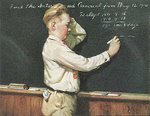I have often found students feeling stymied by the task of choosing a title for their essays. I’ve been there too. I often just get done writing this THING, this organic fusion of thoughts and experiences and facts and outside opinions, and now I have to name it? And not just any name, but something that both gives a fairly clear sense of the actual content of the essay and yet offers a hint of creativity or language play. It’s no wonder academics “cheat” by introducing a colon to the mix; thus, as McDonald’s two-sided Styrofoam McDLT containers kept “the hot side hot and the cool side cool,” the two-sided academic essay title can keep the creative side separate from the quasi-literal side.
Which is taking longer to decompose? The styrofoam containers or the McDLTs?
Similar to the agony of choosing a title (an agony bloggers are not free from), there can be much hand-wringing when choosing an appropriate image to represent your blog. Much like an essay title, this image “labels” the blog. It offers a specific visual to the reader that to some degree influences the tenor of the site. Most popular blogs simply have a logo that incorporates their blog title that serves this function as the blog’s image. We in the 109.02 class are not ready to create custom logos for our oh-so-many followers yet, as I assume that no one in the class is strong enough at HTML to introduce a comprehensive design change, replete with logo. What we can do is let a graphic do the representation for us.
My particular choice of clipart shows a young man, “The Genuine Drafter,” fretting in front of a chalkboard, who appears to be contemplating what he wrote and what he will be writing. I am quite happy with this image, as it captures in the face of the young man what I call “the sweet agony” of the writing act. I have considered changing the image because it looks as if the young man might be currently engaged in a math problem; however, at the picture’s size, all that can be made out for certain is that there is writing on the board, and, truly, the expression of the writer is what I most want my blog image to, ahem, express.
A rejected image. Consternation, yes. Sweet agony? Nuh uh.












